
There are many considerations nursery growers must make when choosing a greenhouse structure. Bill Mathis, sales manager, Atlas Manufacturing, Inc., has guided many growers to the right type of structure for their business. Adding a new structure is a major investment in time and money, so it needs to be done right. From the height to the orientation of the benches, there are a lot of questions that need to be answered before undertaking such a project. Mathis starts by asking a series of questions, probing the dimensions of the new structure, what crops it will house, and the growing method. Once he knows those particulars, he’ll examine local weather trends to inform a decision on how much structural support is necessary.
“You get a feel for what they’re trying to accomplish, then the wind and snow, and environmental conditions of where they’re at, and all those factors guide you to the right structure,” Mathis said.
McCorkle Nurseries markets more than 4 million plants annually from its growing operations delivering to over 1,800 customers in the southeastern and mid-Atlantic states. The growing operation consists of an 820-acre farm of which 440 acres is currently in production. The Dearing, Ga.-based nursery also has a total of 570,000 square feet of gutter-connected greenhouses. McCorkle also has 292,000 square feet of freestanding Quonset-style overwintering houses.
Last year, McCorkle built a 126,000 square foot Gutter Connect range – the nurseries’ fifth range of gutter-connected houses, four of which are identical.
The Gutter Connect ranges are primarily used for overwintering woody ornamentals, said operations manager Chris McCorkle. About 40 Quonset houses are devoted almost exclusively to propagation.
Before taking the plunge, McCorkle did his homework. Although he knew exactly what size greenhouse he wanted, he advises growers that there are still differences between products to be aware of when comparing quotes. When he was analyzing several proposals for the same size greenhouse with identical column width spacing, he noticed some manufacturers used aluminum, some used galvanized steel. Some used round tubing, some used square. Bracing and cabling systems may be different, as well.
“It was important that I was comparing apples to apples,” he said. “While they’re all greenhouses, they’re seemingly spec’d very similarly, the style of the structure and different components that are used can vary quite a bit if you’re not careful.”
Style and coverings
The choice between a gutter-connected and freestanding structure depends on one major factor: expansion plans. If a grower plans on expanding later and wants to keep the expansion under the same roof, a gutter connected structure provides many efficiencies. However, even in a wholesale nursery operation, there are situations where freestanding has advantages. For instance, if you have a disease outbreak in a greenhouse, individual freestanding houses will allow you to stop the outbreak more quickly and easily.
Mathis most often sees freestanding houses used as cold frame type structures to overwinter plant material.
“A customer may say, ‘I want a 30’ x 96’ greenhouse and I don’t plan on growing any more, and if I do grow, I’m going to move to a different spot and put up another 30’ x 96,’” Mathis said. “There are always places where that’s a good fit. But in most cases, Gutter Connect fit the bill when you’re talking about commercial ornamental nursery production.”
When McCorkle Nurseries began adding its greenhouse ranges, Chris McCorkle did an analysis of the cost per square foot of gutter connect vs. freestanding. While the Gutter Connect was a little more expensive per square foot, McCorkle still chose that style of greenhouse for a few reasons. Primarily, space. The Gutter Connect ranges allow him to utilize 100 percent of his available space. With freestanding Quonset houses, a grower has to have at least two feet of space between each house. That’s space that isn’t being used to grow plants.
“When I took that under account, along with the fact that we leave Gutter Connect ranges covered with a longer-term, up to six-year poly, and don’t have to uncover and recover each year, the cost when I compared GC to Quonset range is very similar.”
Mathis says budget is often the biggest dictator in determining the right covering for your greenhouse structure. That's because a double layer of polyethylene film can provide the same insulation value as 8 mm twin-wall polycarbonate. However, the polycarbonate could cost 10 times as much.
“If a customer is in an area that gets serious hail storms during part of the year, it doesn’t make sense to use poly film, Mathis said. “The hail is going to destroy it, tatter it, so they’re going to have to re-cover that film every year. Situations like that can force a customer’s hand into spending more money, but getting something more durable with a warranty against hail damage and a much higher likelihood of surviving the storm.”
The value of the crop is another deciding factor. If you’re growing a low-cost commodity-type item that is sold on pure price, your margins are going to be thin. It would be hard to justify the cost of polycarbonate covering on that type of crop. However, if you grow a high value crop, it’s easier to justify the cost of a much heavier structure.
Reputation matters
When comparing proposals for greenhouse structures, McCorkle asked Atlas for references of other growers who have installed Gutter Connect structures at their nurseries. The horticulture industry is unlike many others, in that its members freely share information, even between competitors.
“That’s the great thing about this industry,” he said. “I can call another grower and they can give me the pros and cons of their experiences with the product and contractor. In our industry, if you have a bad reputation everyone seems to know it.”
McCorkle considers structure choice a value proposition. He could have chosen a less-durable, less-expensive structure, but opted for a product that both he and the manufacturer are confident will withstand any wind or snow load it could possibly encounter. And while he knows his operation’s needs better than anyone, he still asks his greenhouse manufacturer plenty of questions.
“While I have a certain set of requirements I’m going to have for that greenhouse, I’m going to rely greatly on their knowledge and expertise when it comes to their product to spec something they’re confident will meet my needs,” he said.
McCorkle plans to build another range in the next 12 months, and it will probably be another Gutter Connect range. He likes keeping consistent as possible, and has been very satisfied with the product and service he’s received from Atlas so far.
“It’s a high-quality product. And they provide exceptional point-of-sale service, and through installation, the contractors they utilized have been very easy to work with,” McCorkle said. “They just bend over backwards to help in any way they can. It’s easy for someone to quote you something and sell it to you, but our experience with them, they’ve been very responsive to whatever request or need we’ve had through the entirety of this project.”
For more: www.atlasgreenhouse.com
Photo courtesy Creekside Nursery
Get curated news on YOUR industry.
Enter your email to receive our newsletters.Latest from Nursery Management
- Society of American Florists accepting entries for 2025 Marketer of the Year Contest
- Sustainabloom launches Wholesale Nickel Program to support floriculture sustainability
- American Horticultural Society welcomes five new board members
- American Floral Endowment establishes Demaree Family Floriculture Advancement Fund
- The Growth Industry Episode 3: Across the Pond with Neville Stein
- The Growth Industry Episode 2: Emily Showalter on how Willoway Nurseries transformed its business
- March 2025 issue recap
- Gratitude as a marketing strategy






